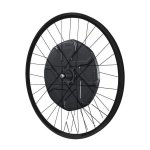APL
100 kW
- Joined
- Aug 6, 2018
- Messages
- 1,113
The cycloidal reduction is a very cool idea! I haven't seen that one yet, but it looks to be very robust, witch is what
we want to see in cycling. Planetary gears don't give me any confidence.
(Can a cycloidal gear reduction be changed very much? Just curious.)
One thing I might suggest is to attach the spokes to the axle flanges instead of the rotor diameters. Axial rotors don't
like side loads very much.
I might also try to make the stator section as narrow, and as large of a diameter as possible. This allows for more coils,
more speed reduction, and more torque. Unfortunately more stator flex too, so there are limits, but being an air core
has the advantage here.
The Bionx D500 motor is an example of some of these ideas. But since things have to fit between the spokes, then that
becomes a problem too. (there are wider rims though)

Trying to keep all this and a cassette between the rear dropouts can be the biggest pain of the design sometimes.
Using a flat stator wind like the Marand motor style may save some space too, although might not be as easy to wind.
Keep up the good work! Your off to a great start! :thumb:
we want to see in cycling. Planetary gears don't give me any confidence.
(Can a cycloidal gear reduction be changed very much? Just curious.)
One thing I might suggest is to attach the spokes to the axle flanges instead of the rotor diameters. Axial rotors don't
like side loads very much.
I might also try to make the stator section as narrow, and as large of a diameter as possible. This allows for more coils,
more speed reduction, and more torque. Unfortunately more stator flex too, so there are limits, but being an air core
has the advantage here.
The Bionx D500 motor is an example of some of these ideas. But since things have to fit between the spokes, then that
becomes a problem too. (there are wider rims though)

Trying to keep all this and a cassette between the rear dropouts can be the biggest pain of the design sometimes.
Using a flat stator wind like the Marand motor style may save some space too, although might not be as easy to wind.
Keep up the good work! Your off to a great start! :thumb:

